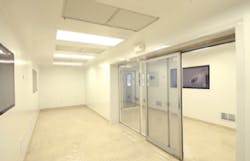Malcolm McLean is a name that few people in pharma know, and yet his 1956 invention is helping to revolutionize drug facilities today. McLean, who passed away in 2001, is the father of the modern day shipping container, which is inspiring a modular facilities boom in our industry. The shipping container provides a convenient size for, say, a cleanroom or facility production add-on, and of course it can be easily, quickly transported to anywhere in the world.
Modular facilities have several layers of appeal. They:
- generally require modest up-front capital investment
- can be built and tested at home before being shipped
- can be moved to wherever they are needed, especially to emerging markets
- are easily standardized to facilitate training and consistent practices between sites
- can be scaled up (or “scaled out”) on an as-needed basis
“Our original target market was R&D type stuff,” says Byrum. But they soon realized there was potential for GMP manufacture, and Biologics Modular produced its first “Alpha Unit” in 2010. A typical unit would be about 80% complete on design when purchased, with full HVAC and other essentials, leaving the remaining 20% to be modified. Biologics Modular works with outside consultants to complete the process-related work, which could mean building as many as three or four production steps in one container. Their first order was a stem cell processing company that required a GMP facility as well as an analytical lab.Byrum says that small and mid-size life sciences manufacturers—those that don’t have significant capital for initial investments—will be the company’s sweet spot, but it has gotten some interest from larger-scale manufacturers as well, and has made bids on projects for 8-9 container systems, he says. “I’m getting pinged by companies I never thought I’d get a call from,” he says.One of the beauties of modularization, of course, is the ease of scale-up. “Most traditional cleanrooms are built 40-50% too big because the company is not sure how much space they’ll need,” he says. Going modular allows a company to add space as-needed, and when needed.Another appeal of modular rooms is tech transfer. The manufacturer can ensure that it has technology in place and in working order, then pick it up and move it wherever it desires—what Byrum would call “absolute tech transfer.”Still, the industry is just warming to the idea of modular facilities. “Our biggest challenge is change,” Byrum says. “We’re trying to change the mindset and show manufacturers a better way to be more efficient.”One of the pioneering forces in pharma modular construction was Pharmadule. (See “Modular Manufacturing: A Paradigm Shift for Pharma Plants.”) That firm has gone bankrupt, but many of its assets are now part of ModularPartners, which is supported by KeyPlants of Stockholm (a former Pharmadule spinoff) and Yonker Industries of Cary, North Carolina. More importantly, the company has some of the key intellectual capital from Pharmadule in the form of Par Almhem, its president, and Camilla Sivertsson, sales and marketing manager.Has the paradigm shifted? A bit, says Almhem. “Modular solutions have gone from being a novelty and something very few would consider, to now being discussed and considered in many (most?) cases. However, few have started to take advantage of the real opportunities in modularization in the way that, for example, the software and electronics industries do.”This requires a change toward more of a “building block” mentality, he says. In addition, “the most significant hurdles have been the tradition of how projects are planned and executed. Modular solutions need to be considered in the early stages of a project in order to get the full benefit of them. Many times, if the question about modularization has been asked, it has been too late.” Modular facilities have also had a reputation for being expensive, Almhem says. “This has sometimes been true, partially because there hasn’t in the past been enough volume to really drive down cost.” Other concerns, such as those having to do with flexibility or regulatory issues, have for the most part been put to rest. The ModularPartners modules are also shipped is a fashion similar to shipping containers. The main difference, Almhem notes, is that the modules are larger and shipped with greater care (with additional weather protection, for example). “There have been thousands of modules shipped around the world with very few incidents,” he explains. “Process modules are shipped in similar ways, but varying depending on the size, sensitivity, etc. of these modules.”






